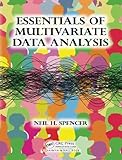Essentials of multivariate data analysis Spencer, Neil H.
Material type: TextPublication details: Boca Raton CRC Press 2014Description: xiv, 172 pISBN:
TextPublication details: Boca Raton CRC Press 2014Description: xiv, 172 pISBN: - 9781466584785
- 519.535 S7E8
| Item type | Current library | Collection | Call number | Status | Date due | Barcode | Item holds | |
|---|---|---|---|---|---|---|---|---|
 Book
Book
|
Ahmedabad | Non-fiction | 519.535 S7E8 (Browse shelf(Opens below)) | Available | 190747 |
Table of Contents:
1. Frequently Asked Questions
1.1. What Questions?
1.2. What Analysis Should I Use?
1.3. What Data Do I Need?
1.4. What Data Is the Author Using in This Book?
1.5. What about Missing Data?
1.6. What about Other Topics?
1.7. What about Computer Packages?
2. Graphical Presentation of Multivariate Data
2.1. Why Do I Want to Do Graphical Presentations of Multivariate Data?
2.2. What Data Do I Need for Graphical Presentations of Multivariate Data?
2.3. The Rest of This Chapter
2.4. Comparable Histograms
2.5. A Step-by-Step Guide to Obtaining Comparable Histograms Using the Excel Add-In
2.6. Multiple Box Plots
2.7. A Step-by-Step Guide to Obtaining Multiple Box Plots Using the Excel Add-In
2.8. Trellis Plot
2.9. A Step-by-Step Guide to Obtaining a Trellis Plot using the Excel Add-In
2.10. Star Plots
2.11. Chernoff Faces
2.12. Andrews’ Plots
2.13. A Step-by-Step Guide to Obtaining Andrews’ Plots using the Excel Add-In
2.14. Principal Components Plot
2.15. A Step-by-Step Guide to Obtaining a Principal Components Plot Using the Excel Add-In
2.16. More Information
3. Multivariate Tests of Significance
3.1. Why Do I Want to Do Multivariate Tests of Significance?
3.2. What Data Do I Need for Multivariate Tests of Significance?
3.3. The Rest of This Chapter
3.4. Comparing Two Vectors of Means
3.5. Comparing Two Covariance Matrices
3.6. Comparing More than Two Vectors of Means
3.7. Comparing More than Two Covariance Matrices
3.8. More Information
4. Factor Analysis
4.1. Why Do I Want to Do Factor Analysis?
4.2. What Data Do I Need for Factor Analysis?
4.3. The Rest of This Chapter
4.4. How Do We Extract the Factors?
4.5. Interpreting the Results of a PCA Factor Analysis
4.6. How Many Factors Are There?
4.7. Interpreting the Results of a PAF Factor Analysis
4.8. Communalities Briefly Revisited
4.9. Rotating Factor Loadings
4.10. So Which Solution Do We Believe?
4.11. Factor Scores
4.12. A Step-by-Step Guide to Factor Analysis Using the Excel Add-In
4.13. More Information
5. Cluster Analysis
5.1. Why Do I Want to Do Cluster Analysis?
5.2. What Data Do I Need for Cluster Analysis?
5.3. The Rest of This Chapter
5.4. How Do We Decide How Close Together Two Cases Are?
5.5. How Do We Decide How Close Together Two Clusters Are?
5.6. How Do We Decide which Distance Measure and Linkage Method to Use?
5.7. How Do We Decide How Many Clusters There Are?
5.8. Interpreting Clusters
5.9. Non-Hierarchical Cluster Analysis
5.10. A Step-by-Step Guide to Cluster Analysis Using the Excel Add-In
5.11. More Information
6. Discriminant Analysis
6.1. Why Do I Want to Do Discriminant Analysis?
6.2. What Data Do I Need for Discriminant Analysis?
6.3. The Rest of This Chapter
6.4. How Do We Decide How Close a Case Is to Different Groups?
6.5. Allocating Individual Cases to Groups
6.6. Which Variables Discriminate between Groups?
6.7. How Accurate Are the Allocations?
6.8. Testing a Discriminant Analysis
6.9. Other Methods of Discriminant Analysis
6.10. A Step-by-Step Guide to Discriminant Analysis Using the Excel Add-In
6.11. More Information
7. Multidimensional Scaling
7.1. Why Do I Want to Do Multidimensional Scaling?
7.2. What Data Do I Need for Multidimensional Scaling?
7.3. The Rest of This Chapter
7.4. Classical Multidimensional Scaling
7.5. Other Methods of Multidimensional Scaling
7.6. A Step-by-Step Guide to Multidimensional Scaling Using the Excel Add-In
7.7. More Information
8. Correspondence Analysis
8.1. Why Do I Want to Do Correspondence Analysis?
8.2. What Data Do I Need for Correspondence Analysis?
8.3. The Rest of This Chapter
8.4. Chi-Square Distances, Inertia and Plots
8.5. More Dimensions
8.6. Row, Column and Symmetric Normalisations
8.7. Correspondence Analysis with More than Two Variables
8.8. A Step-by-Step Guide to Correspondence Analysis Using the Excel Add-In
8.9. More Information
Since most datasets contain a number of variables, multivariate methods are helpful in answering a variety of research questions. Accessible to students and researchers without a substantial background in statistics or mathematics, Essentials of Multivariate Data Analysis explains the usefulness of multivariate methods in applied research.
Unlike most books on multivariate methods, this one makes straightforward analyses easy to perform for those who are unfamiliar with advanced mathematical formulae. An easily understood dataset is used throughout to illustrate the techniques. The accompanying add-in for Microsoft Excel® can be used to carry out the analyses in the text. The dataset and Excel add-in are available for download on the book’s CRC Press web page.
Providing a firm foundation in the most commonly used multivariate techniques, this text helps readers choose the appropriate method, learn how to apply it, and understand how to interpret the results. It prepares them for more complex analyses using software such as Minitab®, R, SAS, SPSS, and Stata.
(https://www.crcpress.com/Essentials-of-Multivariate-Data-Analysis/Spencer/9781466584785)
There are no comments on this title.

